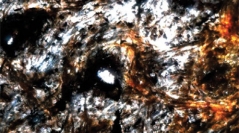

 Comptes Rendus Palevol
16 (7) - Pages 795-803
Comptes Rendus Palevol
16 (7) - Pages 795-803Xenarthran osteoderms are integumentary bones with high fossilization potential presenting a high degree of morphological and histological diversity. Here, new data on the osteoderms histology of two glyptodonts, Panochthus and Neuryurus are presented. The poor spatial organization of the mineralized fibers and a large trabecular area in the middle zone identified in Neuryurus indicate a different bone pattern than the one found in Panochthus, which is mainly characterized by a middle zone with less spongiosa. Through the Bone Profiler program, the degree of compactness of the specimens was obtained, with about 70% for Neuryurus sp. and approximately 90% for Panochthus sp., showing the difference in bone pattern. These values confirm the visible difference in the histological patterns of these taxa, especially in the middle zone. This work demonstrates the microstructural variation studied in osteoderms and shows the importance of paleohistology as a starting point for a better understanding of extinct taxa.
Mammalia, Glyptodont, Histology, Microanatomy, Bone Profiler software